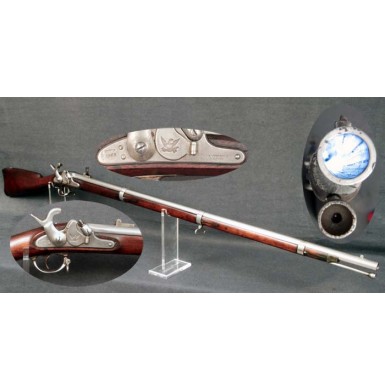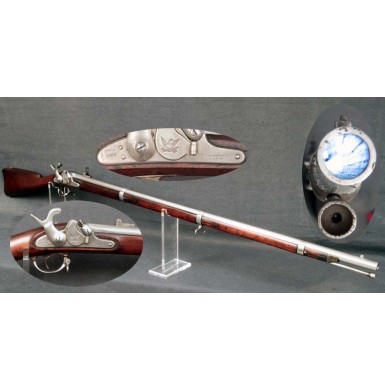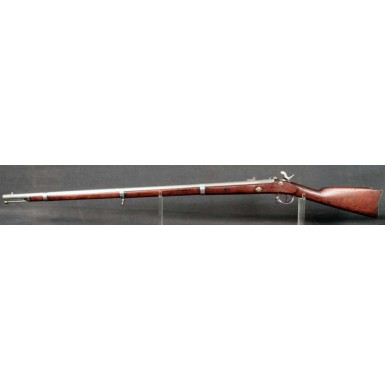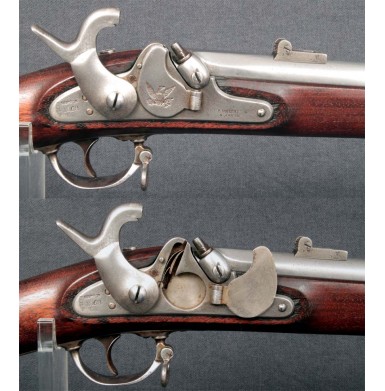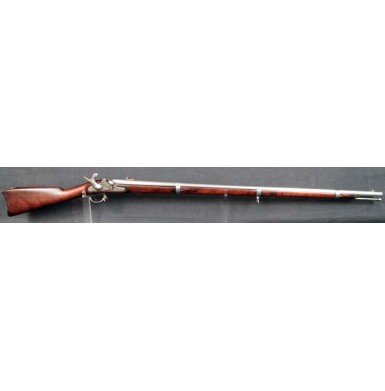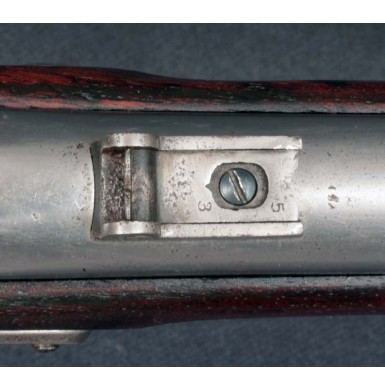Good & Serviceable Whitney M-1855 Rifle Musket - Very Scarce
- Product Code: FLA-1835-SOLD
- Availability: Out Of Stock
-
$1.00
The “Good and Serviceable Arms” produced by the Whitney Arms Company are some of the most interesting, unique and in some cases scarcest of all Civil War era military long arms. The arms were produced in a variety of patterns and styles by Eli Whitney Jr., and in many cases utilized surplus, and in some cases condemned, parts from other Whitney contracts as well as from other manufacturers. Whitney had expended a significant amount of capital in the completion of his US Ordnance Department contracts for M-1841 “Mississippi” rifles, and found himself to have lost money at the completion of the production run. In Whitney’s mind the largest contributing factor to the lack of profitability was the need for the guns to be fully interchangeable, and the stringent gauging and inspection that the US contract arms were subject to. As such, he proposed to produce guns that would be (in his words): “good & serviceable arms, not to be subject to government inspection with gauges.” It is somewhat ironic that the concept of interchangeable parts assembly, the very concept that built the company under his father’s tenure, was seen as the biggest problem for the company by Whitney’s son. Since Whitney relied upon small lots of parts, which he purchased for pennies on the dollar, most of the models produced were in very small quantities - rarely exceeding 1,000 of any one pattern. Whitney procured parts by buying obsolete, surplus, over run and even condemned parts from Europe, Robbins & Lawrence, and the American armories at both Springfield and Harper’s Ferry. The “Good & Serviceable” models resembled “Mississippi” type rifles, British “Enfield” style rifles and rifle muskets, US M-1855 rifles and rifle muskets, as well as other patterns that were purely of Whitney design. The guns were offered to sale to states and private militia groups at a lower price than his competitors could meet, but due to his frugal production methods and minimal outlay for parts, the guns proved to be a very profitable venture for Whitney.
One of the scarcer examples of Whitney “Good & Serviceable” arms was the US M-1855 Type Rifle Musket (Flayderman 5J-036). According to arms historian, researcher and author Howard M. Madaus, Whitney purchased 350 condemned US M-1855 Maynard Tape Primer locks from the Harper’s Ferry arsenal. Unlike the guns built with unfinished M-1855 locks (Whitney “High Hump” and “Low Hump” guns), these locks were complete and functional, with the tape primer mechanism in place. Based upon extant examples, the majority of these locks were dated 1858, although a few were dated 1857 and some were apparently undated (or the dates were removed). Using these locks as a basis, he produced a .58 rifle musket that outwardly resembled the US M-1855, but had a number of unique differences. The guns were iron mounted, with flat, spring retained bands and pewter forend caps. The guns had a pair of brass, wing-shaped lock screw escutcheons, similar to those found on P-1853 Enfield pattern rifle muskets, and were possibly left over parts from the Robbins & Lawrence Enfield contracts. The guns had 40” round barrels that were rifled with 7 grooves. This pattern of rifling is unique to Whitney’s M-1855 type rifle-muskets; with the 7-groove rifling system typically only encountered his shorter rifle length arms. The guns were equipped with one of two patterns of rear sights. The Type I was a long-base ladder sight, similar to those found on early US M-1855 rifle muskets and rifled and sighted US M-1842 muskets. The less common, Type II rear sight, was a simple L-shaped leaf sight with a large aperture hole. The guns utilized simple, straight shank ramrods (instead of the swelled shank rods used on US M-1855 rifle muskets), and typically had tulip shaped heads. Some with brass heads or tips have been noted as well. The guns are usually devoid of any markings (including barrel proofs), other than the re-stamped Whitney markings on the locks. The bands do not bear the usual “U” of US arms, nor do the buttplate tangs have the “US’ mark. As the guns were sold at the state level, the guns are not encountered with US inspector cartouches. According to most researchers, only 350 of these M-1855 Type Rifle Muskets were produced by Whitney, with the majority being delivered to the state of Connecticut. From there it appears that almost all of the guns were issued to the 8th Connecticut Volunteer Infantry. The 8th Connecticut Volunteer Infantry was organized in Hartford in September of 1861 and initially saw service in the Department of North Carolina. From there they joined the Army of the Potomac, serving during Lee’s Maryland Campaign at both South Mountain and Antietam. The 8th also took part in the battle of Fredericksburg. From there they spent a number of months in service on the Virginia peninsula, eventually joining Grant’s army for the battle of Cold Harbor and the Petersburg Campaign. Their final battle was that of Fair Oaks during the final days of the war, and the regiment spent time occupying both Richmond and Lynchburg, VA, before being mustered out at Lynchburg in December of 1865.
The Whitney US M-1855 Type Rifle Musket offered here is in about FINE condition overall. The gun is one of the Type II rifle muskets that has the L-shaped aperture leaf sights. The gun appears to be 100% complete and correct in everyway. The surplus M-1855 lock is complete and mechanically excellent. The lock is secured with two screws, which pass through a pair of Enfield pattern, winged brass washers. The forward portion of the lock plate is marked in two horizontal lines: E. WHITNEY / N. HAVEN. The rear of the lock has the original date 1858, but the “5” appears to have been over-stamped to make it a “6” “ rendering an apparent date of 1868! Whitney was probably trying to re-date the gun and after altering the 5 realized that there was no reasonable way to alter the 8. Whitney applied the additional date information SEPT” 8 over the year. I wish I knew why he thought it was worth adding that additional mark, and wonder if it might indicate the specific date of the state of Connecticut contract for the guns. The very rear of the lock shows the remains of the word “FERRY” from the original Harper’s Ferry marking. The tape primer door retains the original US Eagle marking, of the Harper’s Ferry pattern, with 5 arrows in the left talon. The gun bears no other external markings other than a cryptic 0 / 1 on the top of the barrel, about 3" to the rear of the front sight. This may have been some sort of lot or inventory code for Whitney. The barrel (although cleaned and buffed in the breech area) shows no indication of having had any proof marks. The gun is mostly a bright steel color, and the barrel has been cleaned and lightly polished. The breech area shows somewhat more buffing and polishing and has left a small gap between the breech plug tang. Removing the barrel from the stock shows that the breech plug is original to the barrel and the bottom of the barrel and plug bear matching witness and alignment marks. There are a few tiny patches of minor age discoloration and light oxidation, but in general any discoloration was removed by the cleaning of the barrel. The metal is almost entirely smooth, with only some minor peppering and pinpricking present in the breech and bolster area. The bore of the gun is about FINE and retains excellent 7-groove rifling that is quite deep and crisp. The bore is mostly bright, with some scattered patches of dirt and light frosting in the grooves along its length. The gun retains both of the original sling swivels, as well as the original Type II aperture leaf sight and the original pewter forend cap. What appears to be the original ramrod is in place in the channel under the barrel. It is a full length, straight-shank, tulip-head, iron ramrod, with fine threads on the end. The stock of the gun rates about VERY GOOD+ to NEAR FINE. It is full length and is free of any breaks or repairs. There are a couple of very minor, surface grain cracks apparent. One is to the rear of the lock mortise and the other runs from the rearmost lock screw to the barrel channel. Neither is anything more than a surface stress line along the grain, but they are mentioned for exactness. The stock has been lightly cleaned, but retains good edges and lines with little rounding to edges and leaving no metal proud of the stock. As is appropriate for these muskets, the stock bears no cartouches or acceptance marks. There is some minor wood loss in the form of slivering along the ramrod channel. Otherwise, the stock shows only the normal bumps, dings and handling marks from service and use in the field.
Overall this is a very attractive and extremely scarce rifle musket, of a pattern that is rarely encountered for sale. Whitney military arms could be a collecting specialization in and of themselves. For an advanced collector of US military long arms from the Civil War era, a Whitney M-1855 would be a real coup to add to their collection. Most “good & serviceable” Whitney arms are rather scarce, but his Enfield pattern guns do appear on the market from time to time. I have had the privilege to offer a couple of those Enfield style guns over the years. I have never had the chance to offer for sale one of his M-1855 rifle muskets. With only 350 of the guns produced, and with most of those guns seeing service with a regiment that fought in such major early battles as Antietam, these guns simply did not survive the war in any quantity. When encountered, the guns are usually in very rough and incomplete condition. This is one of those centerpiece rifle muskets that will be a fantastic addition to an advanced collection, and will likely elicit comments like “I didn’t know Whitney made M-1855 rifle muskets’ from your collecting friends. This is a great example of a very scarce gun that you will be proud to own and display.
SOLDTags: Good, Serviceable, Whitney, M, 1855, Rifle, Musket, Very, Scarce

